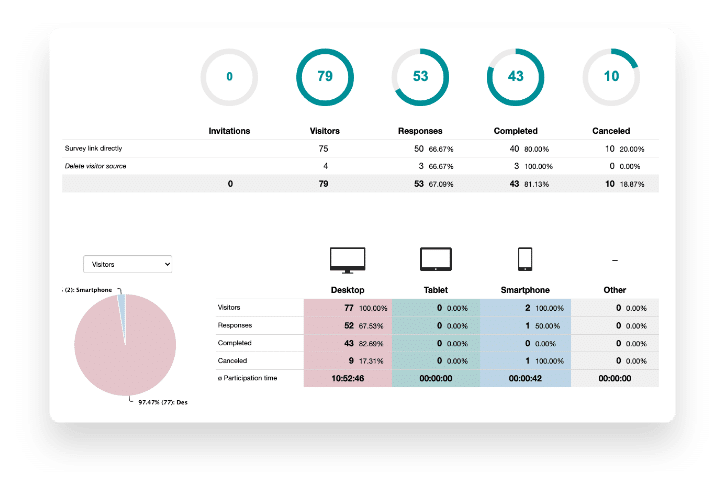Derive recommendations for action from an employee survey


Solutions / Employee Survey / Derive recommendations for action from an employee survey
The results of an employee survey are the basis for deriving recommendations for improvement.
With the following methods, you will find the pain points among employees, which factors influence motivation, and how to define a prioritization of measures at the end.
- Methode: Feedback thematisch Clustern
- Methode: Top-Antworten markieren
- Methode: Hohe und niedrige Resonanz miteinfließen lassen
- Methode: Wiederkehrende Themen
- Methode: Motivationsfaktoren bestimmen
- Methode: Definition der Handlungsempfehlungen
- Methode: ICE-Bewertungsmodell
1st method: Clustering feedback thematically
Before recommendations for action can be derived, you must first find the pain points where action is needed.
To do this, first look at the overall result.

Either as an overall result, as a partial result (segment) or in a comparative result presentation.
Look at the results question by question. If you have placed free text fields for the questions (recommended – because the gold of a survey lies in open questions), then take a look at the quantitative and qualitative data.
When looking at the results and free-text answers, always make a note of the thematic umbrella term: e.g. transparency, team, department or collaboration.
This is important because it will help you identify later which topic is particularly close to employees’ hearts.
2nd method: Mark top answers
While viewing the results, additionally note the “top” response for each question with free text answers.
Top responses refer to employee comments that are particularly negative, particularly positive, or contain a good suggestion for improvement.
The top answers are important for the motivational factors and the recommendations for action that can be derived.
3rd method: Include high and low resonance
When looking at the results, always look at how many employees made a comment on a free-text question.
If a comment was made on almost every question, that speaks well for your employees and their commitment to you as an employer.
Because that shows you that it is important to employees that improvements take place.
At the same time, you can also see which topics are causing the most “pain.”
If the response is low, the issue is not important to many employees; if the response is high, the issue is important. Make an additional note of this in your notes.
4th method: Recurring themes
When reading the results, sometimes the same themes come up again and again.
Note the frequency of the topics.
This will give you an additional indication of where most action is needed by employees.
5th method: Determine motivational factors

You have now collected a wealth of information from the results and structured it into different topics.
From the quantitative and qualitative feedback, you can now deduce what the biggest motivating factors are for your employees and which factors are the most demotivating.
For example:
Motivational factors:
- Appreciation
- Self-determination
- Relationship with the manager
- Flexible work model (home office)
Demotivating factors:
- no adequate communication
- poor cooperation
- rigid structures
- bad atmosphere among colleagues
6th method: Definition of the recommendations for action
Now that you have noted down all the results and comments, you create clusters from them.
That is, you form groups from the comments that you assign to the topics you have identified.
Now this can become quite a lot at first and some comments will surely overlap.
That’s not a big deal.
Once you’ve created the list, unify the comments and merge like or similar ones. You should now have a list where exactly one pain point is named per bulleted list.

In the next step, highlight the topics (not individual points) where there was the most response. After all, these are the topics with the greatest effect on employee motivation.
You now have a structured list of the individual employee pain points and to which topic they belong.
Next, think about countermeasures – individually, as a team or together with the employees.
This may sound exhausting at first, but it’s not.
Because in the top responses with suggestions for improvement, your colleagues have already presented you with proposed solutions.
Take a look at these and try to define them as recommended actions according to your possibilities.
You have now derived recommendations for action from the pain points.
Now you just have to decide which of the actions you will implement and in which order.
There are different ways to do this.
- You can select and implement the 3-5 most frequent points for each topic.
- Or you can prioritize them based on the ICE scoring model.
In either case, you should implement quick actions first.
This shows your employees that their participation in the survey is having an impact.
After all, if no action is taken, your employees will not participate in a survey a second time.
7th method: The ICE Valuation Model
The ICE scoring model is a relatively quick way to assign a value to various potential ideas in order to prioritize implementation based on the value.
This gives you a sensible order of priority and a plan of action.
For prioritization, each action is scored according to three factors.
To do this, create an Excel list, the first column contains the measures and the 2nd, 3rd and 4th columns contain the evaluation based on these factors:
- I = IMPACT: What is the expected impact of this measure?
- C = CONFIDENCE: How confident am I that this measure will have the desired effect?
- E= EASE: How easy is this measure to implement (time required, know-how)?
For each factor, assign a value from 1-10, with 10 indicating the highest level of agreement.
Now you have determined three values per measure.
Multiply these three values together:
- I * C * E = The value that now comes out of this is the prioritization value.
Simply write this in the 5th column of your Excel spreadsheet.
Now sort your list based on the “prioritization value” from column 5.
At the top is the measure with the “highest” value.
This should be the measure you implement first.
Then the second and so on.
Conclusion
Using the above methods and the ICE assessment model, the definition of recommended actions will fit your situation perfectly.
Sort them and work through one action after the other.
Not all measures can always be implemented because of lack of time or budget.
But show your employees that participation has a positive effect.
Further information


